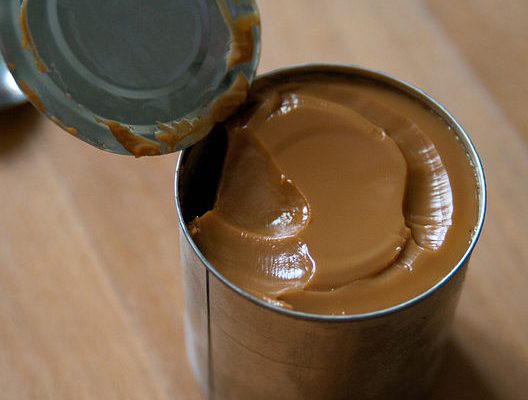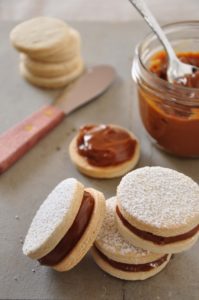
Dulce de leche (including recipes)
OK, first things first. Here’s the super easy recipe for your basic dulce de leche:
Take a can of sweetened condensed milk. Put it into a large saucepan full of water. Heat the water to boiling and keep it boiling for 3 hours. If water boils off, leaving the can exposed on top, add more water. Do not let all the water boil away! That could be dangerous. So check it every so often.
I always put something between the bottom of the pan and the can. That way the can heats evenly from the water. Anything heat-resistant will do. When I visited my parents in Ohio recently, I grabbed a couple pieces of bark from the mulch in their yard and used those.
My brother-out-law Carlos taught me how to do this when he made alfajores. I’ll be forever grateful.
Regional names and a Mexican variation
Dulce de leche goes by a number of different names. In Portuguese, it’s doce de leite. In Spanish, it depends where you’re at. It could be arequipe, leche quemada, manjar, or manjar blanco. And different places may have different standards for how thick it should be, how dark, etc.
A Mexican variation, cajeta, is made with goat’s milk or a mix of goat’s and cow’s milk. This gives it an amazing, very distinctive flavor. If you want to find it in your local grocery store, I’ve seen it bottled in supermarkets under the Nestle’s brand La Lechera (“the milkmaid”).
A word of warning: be careful with the word cajeta! It’s not used this way outside of Mexico – and in some countries it’s a vulgar term for, um, ladyparts.
Crepes with cajeta
My favorite thing to do with cajeta is make crepes with it! In Argentina, crepes with dulce de leche is a standard dessert. I’ve seen it in Panama, too. But I started making these before I knew any of that, and I used cajeta. So that’s still how I do it.
Just take a spoon of it and spread a thin layer around your crepe. (If you think it’s hard to make crepes, drop me a line and I’ll give you the secret.) The sticky cajeta will hold the crepe closed once you roll it up. Perfect finger food, not messy unless you use too much filling.
I’m not one for fancy crepes topped with whipped cream, powdered sugar, and lots of fruits and syrups. Give me a flavorful crepe wrapped around a sinfully delicious filling, and I’m completely happy. But this is the one crepe where I add something to the filling. Take some chopped pecans, toast them in a pan, and sprinkle them on top of the cajeta before you roll up the crepe. It’s kind of heavenly.





Write Your Comment